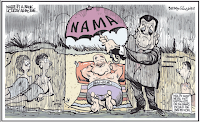 The last day of the legal term sees the builder’s bail out hovering on the precipice. The refusal of examinership to Liam Carroll’s group of companies will strengthen the arm of ACC Rabobank in their campaign to hold on their AAA credit status and muscle the government into a bank buy back while rescuing some liquidity for themselves. Ironically almost 20 years ago the Dail was recalled from a summer recess to put through examinership laws to rescue then FF supporter Larry Goodman. Now another recall is on the cards to bailout more FF supporters, the top 50 developers in the country and their lending institutions through NAMA. The best endorsement for NAMA that explains it to most people was the Green Party description of it as "the best least worse option". Make no m,istake about it the Dail will be back early as the inertia wears down what's left of the specualtors bubble.
The last day of the legal term sees the builder’s bail out hovering on the precipice. The refusal of examinership to Liam Carroll’s group of companies will strengthen the arm of ACC Rabobank in their campaign to hold on their AAA credit status and muscle the government into a bank buy back while rescuing some liquidity for themselves. Ironically almost 20 years ago the Dail was recalled from a summer recess to put through examinership laws to rescue then FF supporter Larry Goodman. Now another recall is on the cards to bailout more FF supporters, the top 50 developers in the country and their lending institutions through NAMA. The best endorsement for NAMA that explains it to most people was the Green Party description of it as "the best least worse option". Make no m,istake about it the Dail will be back early as the inertia wears down what's left of the specualtors bubble.Basically it works like this. Bank sells bad (toxic) loans to NAMA and is paid in bonds at a reduced price (discount). NAMA gets to work through these loans with the developer. The theory is that the tax payer won’t be hit because the developer will then be able to draw down money from the bank to complete construction while paying off NAMA. In theory at the end of the day the government thinks it will get back whatever it puts in.
But will this work in practise? When tribunals were being set up we heard that they would raise cash because findings would be actionable by Revenue. The problem was that those with a vested interest trot off to the High Court at the drop of a hat to protect their interests. Costs soared and the tax payer was hit. A developer may well go to the High Court to challenge a move by NAMA or indeed the very legislation that sets up NAMA.

What’s often forgotten is that many of the bad loans handed out are in relation to foreign property investments. I see no value to our economy in bailing out these however the reality is that with many of these in the north or Britain, they have more potential for recovery on the loans than many of the Irish properties destined for NAMA. As Jack O’Connor asks what will be the social role for NAMA in housing? Will the residential property be used to house those on the housing list by the state? My feeling on the matter is that with other econmies set to enter recovery before Ireland’s emigration will increase further reducing the demand for housing and depressing prices and demand. As a consequence to remove the overhang would it not make sense for the state to take up empty residential units as part of the charge to developers within the NAMA basket?
What about completed developments where no purchaser is interested? What should be done with the entirely speculative properties that were built and will not be filled? In the 19th century free market liberal economics meant that Ireland had deserted villages after the famine. Has our economic thinking moved on in 160 years? I doubt it!
My biggest concern with NAMA is in relation to the values put on properties. Which values determine the value on which the discount is established? Are these values the ones when NAMA was set up or when the market was at its peak or when the loans were taken out? I’m worried at what may ensue behind closed doors when it comes to the negotiations to set values. Already we've seen Carroll been accused by the judge of guilding the lily when it comes to values which he claimed were independently established. Can you trust any of these developers who specualted on sentiment as if it was hard currency and how can you protect the taxpayer at the same time?
Either way the tax payer will either give the developer a soft deal and have to compensate the banks or else bail out the banks and effectively re-ignite property speculation based on a tax payer subsidised depression of property prices. Heads they win, tails we lose!
No comments:
Post a Comment